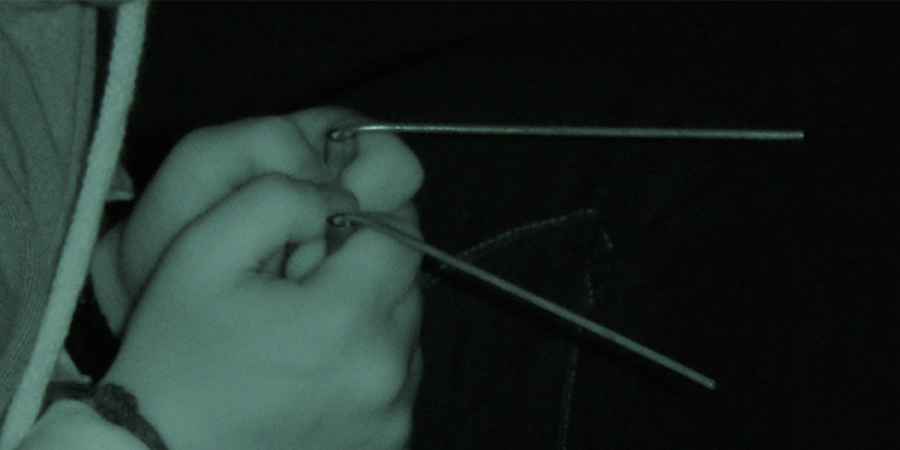Dowsing Rods As A Method Of Spirit Communication In Paranormal Investigations

When it comes to the methods used in paranormal investigation, few have as much history and mystery associated with them as dowsing, but it's also fair to say that few are as controversial and divisive.
Traditionally, dowsing is a method used to locate underground water, minerals, or other hidden substances using rods, but it has found a place in the toolkit of many paranormal investigators for spirit communication during ghost hunts. Some suggest that the rods act as conduits for spiritual energy, allowing the dead to communicate through them.
The basic tool for dowsing in paranormal investigations is a pair of L-shaped metal rods, typically fashioned from materials like copper or brass. Each rod is held in one hand, with the short arm of the 'L' kept vertical while the longer arm points forward. This setup allows the rods to move freely, responding to questions asked by the dowser.
In a typical ghost hunting scenario, the key is to hold them steady, allowing any movement to be potentially attributed to external forces. Investigators often start by asking simple 'yes' or 'no' questions. For instance, they might designate a swing to the left for 'yes' and a swing to the right for 'no'. This setup creates a basic form of communication, enabling the investigator to ask a series of questions and interpret the rods' movements as responses.
Another common use is asking the spirit to direct the rods towards their location in the room. This request, "Point the rods to where you are," aims to establish the presence of a spirit and potentially gauge its movement or location. If the rods converge or point in a specific direction, this is taken as an indication of the spirit's presence in that area.
Some teams use dowsing rods to track the movement of spirits through a space. By asking the spirit to move the rods in the direction it is moving, investigators try to follow its path. This technique is often used in larger spaces or when trying to determine the boundaries of a spirit's presence in a particular area.
The accessibility of dowsing rods adds to their popularity in ghost hunting. They can be easily made from household items like wire coat hangers or lengths of copper wire bent into the requisite L-shape. This DIY aspect appeals to some who are keen to explore the paranormal without a significant financial investment.
One popular theory that is used as a possible explanation for the mechanism behind dowsing is that the rods react to subtle energy fields. Proponents of this idea suggest that spirits, or entities from the afterlife, are comprised of or interact with energy in a way that's detectable by the rods. This energy could be electromagnetic, a form of energy that's all around us but is usually invisible and intangible. The concept is that spirits might be able to manipulate these fields to guide the rods' movements, providing responses to questions or indicating their presence.
Then there's the idea of psychokinesis, the ability to move objects with the mind. If we entertain the possibility that spirits retain some form of consciousness, they might be able to influence physical objects, like dowsing rods, using this ability. This theory hinges on the belief in a consciousness that survives death and retains the ability to interact with the physical world.
Despite their popularity in ghost hunting, the use of dowsing rods is not without its critics. Skeptics point out that the movements of the rods can be easily influenced by the ideomotor effect. This psychological phenomenon is where a person's subconscious mind influences the body to move unconsciously, these unconscious muscle movements cause the rods to move. This means that the investigator's expectations or subconscious thoughts could cause the rods to move, rather than any external paranormal force. This undermines the validity of dowsing as a tool for paranormal communication and poses a significant challenge in proving that the movement of the rods is indeed due to supernatural influences and not just subconscious human actions.
Another concern is the issue of subjective interpretation of the rods' movements. The movement, being subtle and often minimal, is open to personal interpretation. What one investigator might consider a definitive response, another might see as mere coincidence or involuntary muscle movement. This subjectivity can lead to inconsistent and unreliable results, making it difficult to establish a standardised method of interpretation in ghost hunting.
Dowsing rods typically move in simple ways: crossing, uncrossing, or pointing in certain directions. Interpreting these movements as complex messages or responses from spirits requires a leap in logic, as the rods' limited range of motion doesn't provide a clear and direct means of communication. This ambiguity often leads to more questions than answers.
Dowsing in the context of paranormal investigation is a blend of age-old practices and modern-day ghost hunting techniques. While it continues to be a subject of debate, with skeptics and believers providing their own perspectives, it can be a fun and interesting area of research and exploration, even if from a psychological perspective.
More Essential Parapsychology View All
Related Content
Daily Horoscopes
You May Also Like
























